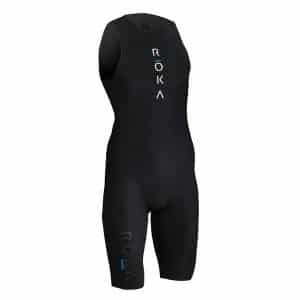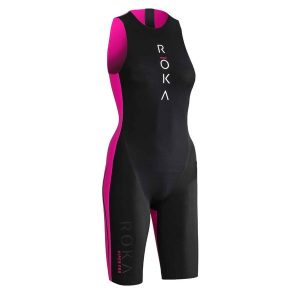Hey SB Tri Team,
 Race season is about to swing into full gear!
Race season is about to swing into full gear!
As the weather warms up, you may have a warm water race or two on your calendar. I thought this would be a great time to share some info that you can pass along to your athletes about swimskins: why they make you (a lot!) faster, how they should fit, and what races you can expect to need them at.
PLUS… Over the next 72 hours only, we're offering ROKA Teams an additional 5% discount on all Viper Swimskins (i.e., a limited time 30% discount – so a 5% addition on top of your normal 25% discount). Just use this special code at checkout to take advantage:
**Remember, If you are a paid member and logged in you will see the discount code below!
Check out our men's collection here and our women's collection here.
Now for some information on swimskins. In my experience, a swimskin is the least understood piece of equipment for the average triathlete I meet. Hopefully some of this proves to be educational for you or your teammates!
WHAT MAJOR RACES ARE TYPICALLY SWIMSKIN RACES?
The following major events are typically either always non-wetsuit or borderline. If you’re planning to race any of the following, best to get your Viper now so you're ready to race!
• Ironman World Championships
• 70.3 World Championships
• Ironman Texas
• Ironman Chattanooga
• Ironman Maryland
• Ironman Louisville
• Honu 70.3
• Eagleman 70.3
• Buffalo Springs 70.3
• Muncie 70.3
• Racine 70.3
• Ohio 70.3
• Boulder 70.3
• Maine 70.3
• Atlantic City 70.3
• Augusta 70.3
• New Orleans 70.3
HOW MUCH FASTER DOES A VIPER SWIMSKIN MAKE YOU?
In our experience, athletes find that a Viper Pro gives them 2 to 6 seconds per 100 meters vs. a jammer or one-piece women’s training suit. Strong swimmers will be closer to the 2s/100, and developing swimmers will be closer to 6s/100. The speed gain is even greater if you compare vs. a tri race kit, which may balloon and cause more drag than a swimsuit. The speed gain is also greater as you fatigue during the latter part of a swim.
WHY DOES A VIPER SWIMSKIN MAKE YOU FASTER?
How can a suit that doesn’t give you buoyancy make you faster? There are several reasons:
1. A swimskin lowers surface drag. The hydrophobic coating on the Viper X, Viper Pro, and Viper Elite makes the suits extremely slippery in water. Pour water on them, and you’ll notice that the water doesn’t soak in, but beads up and slides right off. The same thing happens to the water that you swim through – it is repelled by the suit and has very little frictional interaction with the suit as you move forward. The result: lower surface drag + faster swimming.
• A swimskin reduces form drag. Your body and your tri race kit have all sorts of ripples and contours. Your race kit may flap around in the water. All of these things mean you have to move more water out of your way in more different directions in order to move forward. Moving extra water takes extra energy, and this resistance is called form drag. A Viper swimskin – particularly a snug-fitting one – smooths these wrinkles over and makes them into long, flowing lines that water can flow over without a lot of energy.
• A swimskin helps you maintain your body line. This is the least obvious reason, but it’s the most important: in swimming, body line equals speed. This is why experienced swimmers can swim so fast with so little effort, while developing swimmers can spend twice the energy and not go nearly as fast. Experienced swimmers keep a straight body line; developing swimmers tend to wiggle, or “snake” as they swim. A swimskin – again, a snug-fitting one especially – simply prevents you from wiggling as much. We have an interesting story from product development that illustrates this point. Several years ago, we were testing a potential new material for the Viper Pro. The new material had the same coating (and thus the same surface drag) as the existing suit, but the new material had more stretch, and our hypothesis was that the additional stretch would result in better performance. However, as we tested the suits, the existing material – the less flexible one – was consistently one second faster per 100m. This crept up toward 2s/100m as the tester fatigued and lost the strength to maintain body line as effectively. From this, it became clear that for optimal speed, we should be designing more, not less, rigidity through the core of the suit. This is where the idea for the Viper X was born.
 HOW SHOULD A VIPER SWIMSKIN FIT?
HOW SHOULD A VIPER SWIMSKIN FIT?
If you just finished reading the previous section, you probably picked up that for optimal performance, a Viper swimskin should fit tightly. How tightly? Here’s a good rule of thumb: if you can get it on without another person zipping you up from behind while you squeeze your shoulder blades together, it’s too loose.
My colleague Michael has a story he likes to tell where, during a demo swim at Kona, he was getting ready for a swim in a size Small Viper Pro. Someone that was the almost exactly his same size came up to him and requested to trade his size L demo suit for a size XL because he thought the size L was too small. The gentleman was expecting it to fit like a swimsuit or bike shorts, but a swimskin should be much, much more compressive than either of those garments.
When trying on a swimskin, there are a few things to keep in mind. (1) You’ll want to put your race kit underneath, as you will wear it over a race kit during a race. (2) It’s important to understand that the degree of compression you feel on land will be different from what you feel while swimming. While the compressive properties of the material don't change when wet (i.e. it doesn’t technically “loosen up”), the shape of your body does change when you swim. Try lifting your arms above your head – do you notice how your rib cage narrows and your belly sucks in? This is the shape your mid-section takes when you swim, and the fit of your swimskin should take into account this narrowing. This is why you can expect a well-fitting swimskin to feel more compressive when you’re standing with your arms at your side than when you’re swimming.
Having said all of this, it’s important to add that there is nothing wrong with opting for a less compressive fit if it makes you more comfortable. You’ll lose some of the body line and form drag benefits of a tighter suit, but you’ll still get a lot of the benefit of a swimskin. Just know that our size charts are set up with the ultimate performance fit in mind, so if you’re looking something less compressive, you will want to size up.
RULES TO KNOW
IRONMAN’s 2017 rules regarding the use of swimskins and wetsuits can be found here starting on page 12. A few key takeaways:
• Wetsuits are not allowed in water temperatures above 76.1 °F / 24.5 °C.
• At some races, IRONMAN may make wetsuits “optional" for water temperatures between 76.1 and 83.7 °F / 24.5 and 28.7 °C. However, athletes wearing wetsuits at these races will be ineligible for awards or Kona-qualifying spots.
• Your tri kit may extend outside of your swimskin as far as the elbow. IRONMAN had a rule prohibiting this in the past, but it has changed in the current rules, per Section 4.03(f).
USA Triathlon’s current rules regarding the use of swimskins can be found here. A few key points:
• Wetsuits are not allowed in water temperatures above 78 °F.
• Wetsuits are “optional" for water temperatures greater than 78 °F and less than 84 °F. However, athletes wearing wetsuits at these races will be ineligible for prizes or awards.
HOW LONG SHOULD A SWIMSKIN LAST?
A swimskin is a race-specific product, and it won’t last forever. It’s best to swim in it 3-4 times in the weeks leading up to a race (this will let your skin build some toughness and reduce chafing on race day), then race in it. But it’s not meant to be a train-every-day product.
For a Viper X or Viper Pro, the hydrophobic coating will wear off after about 20-30 uses (maybe fewer if you wring it out, let it get tossed around, stuff it in bags, etc.; maybe more if you are careful to avoid things rubbing against the suit or the suit rubbing against itself). After that, it will still retain its compressive material properties due to the robust stretch-woven material, but it won’t have the same surface drag reduction benefits that it did when new.
A Viper Elite will have a similar life for the hydrophobic coating, but because it is a knit and not a woven material, it will experience a slight reduction in the compressive properties of the material over time.
A Viper Comp does not have hydrophobic coating, so there will be no change to the surface drag properties of the suit, but because it is a knit, it will see compressive properties decline over time, similar to the Viper Elite.

